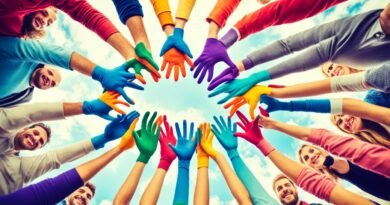What is Omnisexuality Understanding This Sexual Orientation
Omnisexuality is a captivating and often misunderstood facet of the LGBTQ+ spectrum. As a distinct form of multisexuality, omnisexual individuals are attracted to people of all gender identities and expressions, including men, women, nonbinary, and beyond. While the terms “omnisexual” and “pansexual” are sometimes used interchangeably, there are nuanced differences that are important to grasp.
In this comprehensive article, we’ll delve into the definition of omnisexuality, explore how it differs from related orientations like pansexuality and bisexuality, and dispel common myths and misconceptions. By shedding light on this often overlooked identity, we aim to foster a deeper understanding and inclusive support for omnisexual individuals within the broader LGBTQ+ community.
Key Takeaways
- Omnisexuality is a sexual orientation where a person is attracted to individuals of all genders, including men, women, nonbinary people, and other gender identities.
- Omnisexuality falls under the broader category of multisexuality, which includes bisexual, polysexual, and pansexual individuals.
- Omnisexual individuals may face misconceptions and discrimination, even within the LGBTQ+ community, due to a lack of understanding about their identity.
- Omnisexuality differs from pansexuality in that omnisexual individuals acknowledge gender in their attractions, whereas pansexual individuals may describe themselves as gender-blind.
- Seeking support and resources, both online and in-person, can be crucial for omnisexual individuals navigating their identity and relationships.
Introduction to Omnisexuality
Omnisexuality is a captivating and increasingly recognized sexual orientation where individuals experience attraction to people of all genders, including men, women, non-binary, and other gender identities. This expansive and inclusive orientation falls under the vibrant LGBTQ+ spectrum, a community that celebrates diverse sexual and gender expressions. As society’s understanding of sexual identity continues to evolve, the LGBTQ+ community welcomes the rich tapestry of omnisexual individuals, each with their unique stories and perspectives.
Defining Omnisexual Orientation
At its core, omnisexuality is the sexual, romantic, and emotional attraction to people of all gender identities. Omnisexual individuals may have preferences or tendencies towards certain genders, but their attraction is not limited by or dependent on gender. This orientation acknowledges the wide spectrum of gender identity and expression, embracing the fullest range of human diversity.
Omnisexuality in the LGBTQ+ Spectrum
As the LGBTQ+ community continues to grow and evolve, omnisexuality has carved out its own distinct place within the spectrum. Alongside identities like lesbian, gay, bisexual, and transgender, omnisexuality represents a gender-inclusive attraction that is unique and deserving of recognition. By celebrating the myriad of sexual and gender identities, the LGBTQ+ community fosters a sense of belonging and solidarity for omnisexual individuals.
“Omnisexuality is the sexual attraction to people of all sexes and gender identities.”
omni sexuality meaning: Attraction to All Genders
Omnisexual attraction is a romantic, emotional, or sexual attraction to people of all genders, regardless of their gender identity or biological sex. An omnisexual person may experience attraction to individuals who identify as male, female, nonbinary, genderqueer, gender fluid, or any other diverse gender expression. This doesn’t mean that omnisexual people are attracted to everyone, as they still have preferences for different characteristics, such as personality or physical appearance.
Omnisexuality is part of the multisexuality category, which includes individuals attracted to more than one gender. People identifying as omnisexual may encounter confusion with other sexual orientations within the multisexuality group, possibly leading to misconceptions about their identity.
Terms like pansexual and omnisexual are commonly used interchangeably, but there are distinctions between them in terms of attraction to individuals based on gender recognition. Omnisexual individuals acknowledge gender in their attractions, while pansexual individuals may describe themselves as gender-blind.
| Characteristic | Omnisexuality | Pansexuality |
|---|---|---|
| Attraction | Attraction to all genders, with gender being a factor in attraction | Attraction regardless of gender, with gender not being a factor in attraction |
| Gender Recognition | Acknowledges gender | Gender-blind |
There is a lack of readily available information specifically on omnisexuality, leading to potential challenges in understanding and identifying within the spectrum of sexual orientation. Misconceptions about omnisexual individuals include assumptions about their willingness to settle down and their perceived promiscuity.
Omnisexual individuals who feel confident in their identity may seek to educate and share their experiences within the LGBTQIA+ community, aiming to clarify misconceptions and provide support.
“As understanding of gender and sexual orientations evolves, the range of sexual preference labels continues to expand, reflecting a broader recognition of diverse identities and expressions within the spectrum.”
Distinguishing Omnisexuality and Pansexuality
Omnisexuality and pansexuality are two distinct sexual orientations that are often confused or mistaken for each other. While they share similarities in their broad acceptance of diverse gender identities, there are crucial differences in how they approach and define attraction.
Pansexuality: Gender-Blind Attraction
Pansexual individuals are attracted to others regardless of their gender. They are often described as being “gender-blind,” meaning that they do not consider gender as a factor in their romantic or sexual attraction. Pansexuals are represented by a flag with pink, yellow, and blue colors, symbolizing their attraction to all identities.
Omnisexuality: Gender-Inclusive Attraction
In contrast, omnisexual individuals are sexually and romantically attracted to people of all genders, but they acknowledge and appreciate the gender of their partners. Omnisexuals may exhibit a slight gender preference in their attraction, but they do not have a specific gender requirement. The omnisexual identity flag features horizontal stripes of light pink, pink, light blue, blue, and dark blue, reflecting the gender-inclusive nature of their orientation.
It’s important to note that while omnisexuality and pansexuality share similarities, they are distinct sexual orientations. Pansexuals are described as being “gender-blind,” while omnisexuals place importance on the gender of their partners, even if they are attracted to people of all genders.
| Pansexuality | Omnisexuality |
|---|---|
| Attraction regardless of gender | Attraction to all genders, with an awareness of gender |
| Represented by a pink, yellow, and blue flag | Represented by a flag with light pink, pink, light blue, blue, and dark blue stripes |
| Pansexual Visibility Day is celebrated on May 24 | Omnisexual Awareness Day is observed on March 21 |
Understanding the nuanced differences between omnisexuality and pansexuality is crucial for promoting accurate representation and fostering a more inclusive LGBTQ+ community.
Omnisexuality vs. Bisexuality
While omnisexuality and bisexuality share similarities in their attraction to multiple genders, there are distinct differences between these two sexual orientations. Bisexuality encompasses a wide range of identities and attractions to more than one gender, with some referring to it as bi+. This umbrella includes various identities like bi/bisexual, pansexual, queer, fluid, non-monosexual, heteroflexible, homoflexible, omnisexual, and polysexual. Initially used to describe an attraction towards women and men, bisexuality now includes attraction towards two or more genders and embraces a spectrum of gender identities beyond the female/male binary.
On the other hand, omnisexuality is typically defined as being attracted to people of all different genders, including men, women, and individuals outside traditional gender categories. While pansexuality focuses on attraction regardless of gender, omnisexuality, although similar, may still consider gender as a factor in attraction for some individuals.
There is a slight distinction between pansexuality and omnisexuality in that pansexual individuals are usually attracted to people irrespective of gender, whereas omnisexual individuals may experience different attractions based on gender or have gender preferences. Bisexuality, in contrast, does not necessarily include attraction to all genders; it signifies an attraction to two or more genders, allowing for the uniqueness of each person’s attractions and identities.

Ultimately, the choice between identifying as bisexual, pansexual, or omnisexual is a personal decision, based on individual comfort and understanding. It is crucial to respect individuals’ preferences in self-identifying terminologies and to inquire respectfully about their orientations if unsure.
Discussing Omnisexuality in Relationships
As an omnisexual individual, discussing your sexual orientation with partners, friends, and family can be a meaningful way to foster understanding, build trust, and seek support. These conversations, however, can also be challenging due to the lingering stigma and misunderstanding surrounding omnisexuality. By initiating these discussions with care and empathy, you can help break down barriers and promote greater acceptance within your personal relationships.
Tips for Talking About Omnisexuality
When discussing your omnisexual identity, consider the following tips:
- Educate yourself first. Familiarize yourself with the nuances of omnisexuality, its differences from pansexuality and bisexuality, and the unique experiences of omnisexual individuals.
- Choose the right time and place. Select a moment when your conversation partner is receptive and you both feel comfortable engaging in a thoughtful dialogue.
- Emphasize your personal experiences. Share how your omnisexuality shapes your identity, relationships, and life experiences, rather than focusing on clinical definitions.
- Set boundaries and encourage questions. Make it clear that you are open to discussing your orientation, but also establish limits on what you are comfortable sharing.
- Be patient and understanding. Your conversation partner may have questions or require time to fully grasp the concept of omnisexuality. Approach the discussion with empathy and a willingness to educate.
Respecting Boundaries and Seeking Support
As you navigate discussing your omnisexual identity, it’s crucial to respect your own boundaries and seek support when needed. Consider connecting with LGBTQ+ organizations or online communities that can provide a safe space to share your experiences and receive guidance. Remember, your omnisexual identity is valid, and you deserve to feel accepted and affirmed in all your relationships.
“Sharing your omnisexual identity with others can be a profoundly vulnerable experience, but it is also an opportunity to foster understanding and build deeper connections.”
The Omnisexual Pride Flag
The omnisexual pride flag is a powerful symbol of visibility and representation for the omnisexual community. Designed in 2015, this vibrant flag features a distinct color scheme that holds deep meaning and significance.
Colors and Symbolism of the Flag
The omnisexual flag consists of five horizontal stripes of equal width, each representing a different aspect of the omnisexual experience. The light pink and light blue stripes symbolize the gender spectrum, acknowledging that omnisexuality encompasses attraction to individuals across the gender identity spectrum. The dark pink and dark blue stripes represent attraction to women and men, respectively, while the central purple stripe signifies attraction to individuals of all other gender identities, including non-binary, genderfluid, and those who do not conform to traditional gender norms.
This intentional color selection serves as a visual reminder that omnisexuality is a valid and legitimate sexual orientation, encompassing a diverse range of gender identities and expressions. The omnisexual flag stands as a proud declaration of one’s identity and a call for greater understanding and acceptance within the LGBTQ+ community and beyond.

“The omnisexual flag is a symbol of our community’s unity, diversity, and unwavering self-love. It reminds us that our attraction knows no bounds and that we are worthy of celebration and respect.”
Diversity Within Omnisexuality
Omnisexuality is a rich and diverse sexual orientation within the LGBTQ+ spectrum. Omnisexual individuals can have a wide range of gender identities and gender expressions. From female (she/her) to male (he/him), and non-binary or genderqueer (they/them), the omnisexual community encompasses people of all gender diversities.
Just as gender exists on a spectrum, so too does omnisexual attraction. Some omnisexual people may find themselves drawn to certain traits or characteristics only when displayed by a specific gender. Others may experience an equal, all-encompassing attraction regardless of their partner’s gender identity. The fluidity and nuance within omnisexuality are what make it such a rich and multifaceted sexual orientation.
It’s important to remember that omnisexual and unromantic are not mutually exclusive terms. An individual may identify as omnisexual in terms of their sexual attraction, while also experiencing omniromantic feelings and desires. The interplay between sexual and romantic orientations adds another layer of diversity to the omnisexual experience.
Despite this vibrant tapestry of omnisexual gender identities and expressions, representation in mainstream culture remains limited. Raising awareness and fostering understanding of the diversity within omnisexuality is crucial for creating a more inclusive and affirming world for all.
“Omnisexuality is a spectrum, and there is no one way to be omnisexual. Every omnisexual person’s experiences and preferences are unique.”
Whether you identify as omnisexual or simply want to be a better ally, embracing the diversity in omnisexuality, respecting individual identities, and challenging societal norms around sex, gender, and sexuality are important steps towards a more inclusive future.
Finding Support as an Omnisexual Person
Navigating the journey of self-discovery and identity as an omnisexual individual can be both liberating and challenging. However, you don’t have to go through it alone. Whether you’re exploring your omnisexual orientation or supporting a loved one, there are a wealth of resources and communities available to provide understanding, validation, and a sense of belonging.
Online and In-Person Resources
The internet has become a lifeline for many omnisexual people, offering a safe space to connect with like-minded individuals and access information. Online forums, discussion boards, and social media groups can be invaluable sources of omnisexual support and omnisexual resources. These platforms allow you to share your experiences, ask questions, and find solidarity within the LGBTQ+ support for omnisexual community.
In addition to virtual communities, many local LGBTQ+ organizations and community centers offer in-person support groups, counseling services, and educational workshops specifically tailored to the needs of the omnisexual population. These spaces can provide a sense of belonging, facilitate meaningful connections, and empower you to navigate the unique challenges you may face.
“Finding a community of fellow omnisexual individuals has been truly transformative for me. It’s amazing to feel seen, heard, and accepted for who I am.”
Seeking support, whether online or in person, can be a crucial step in fostering self-acceptance, building resilience, and creating a network of allies. Remember, you are not alone in your journey, and there are resources available to help you thrive as an omnisexual person.
LGBTQ+ Organizations and Community Centers
In addition to online resources, many LGBTQ+ organizations and community centers offer specialized programs and services for omnisexual individuals. These can include:
- Support groups and discussion forums
- Counseling and mental health services
- Educational workshops and training
- Advocacy and legal assistance
- Social and recreational activities
Connecting with these local and national organizations can provide a sense of community, access to valuable resources, and the opportunity to engage in the broader LGBTQ+ support for omnisexual movement. By leveraging these support systems, you can find the guidance, validation, and empowerment you need to thrive as an omnisexual individual.
Conclusion
Omnisexuality is a captivating and multifaceted sexual orientation that embraces attraction to individuals of all gender identities. While omnisexual individuals may share certain commonalities, each person’s journey of self-discovery and preferences is uniquely their own. From the initial spark of attraction to a trans individual in a college course to the realization of an all-encompassing curiosity beyond physical appearance, the path to omnisexual identity is paved with personal growth and self-acceptance.
Whether an omnisexual person chooses to use traditional labels or forgo them entirely, the LGBTQ+ community celebrates the diversity of sexual and gender expressions. By fostering understanding and representation, we empower omnisexual individuals to embrace their authentic selves and forge meaningful connections. As we continue to explore the nuances of omnisexuality, may we all strive to create a world where love and acceptance know no bounds.
As the omnisexual flag boldly declares, the spectrum of human sexuality is a vibrant tapestry, woven with the threads of light pink, pink, light blue, blue, and purple. Let us embrace this kaleidoscope of identity, and in doing so, unlock the boundless potential for love, understanding, and self-discovery.
FAQ
What is the definition of omnisexuality?
Omnisexuality is a sexual orientation in which a person is attracted to people of all genders, including men, women, nonbinary people, and other gender identities.
How does omnisexuality differ from pansexuality?
While both omnisexuality and pansexuality involve attraction to people of all genders, the key difference is that omnisexual people acknowledge and consider gender in their attractions, whereas pansexual people describe themselves as being “gender blind.”
What is the distinction between omnisexuality and bisexuality?
Omnisexuality emphasizes attraction to people of all genders, while bisexuality means attraction to two genders, but not necessarily every possible gender identity. Bisexuality is not limited to the traditional gender binary (male/female).
How can I discuss omnisexuality in my relationships?
Discussing omnisexuality in relationships can be a meaningful way to foster understanding, build trust, and give and receive support. Tips include educating yourself, choosing the right time and place, emphasizing personal experiences, setting boundaries, encouraging questions, being patient and understanding, and seeking support from LGBTQ+ organizations.
What does the omnisexual pride flag represent?
The omnisexual flag has five horizontal stripes of equal width, with colors representing the gender spectrum, attraction to women and femininity, attraction to men and masculinity, and attraction to people of all other genders, including nonbinary people, genderfluid people, and people of different gender identities.
Is there diversity within the omnisexual community?
Yes, omnisexuality is a spectrum, and there is no one way to be omnisexual. Every omnisexual person’s experiences and preferences are unique. People of all gender identities and gender expressions can be omnisexual.
Where can omnisexual people find support?
Resources for omnisexual people include online forums, in-person support through local LGBTQ+ community centers, and LGBTQ-focused organizations such as The Trevor Project, Out & Equal, GLAAD, and the Human Rights Campaign.



